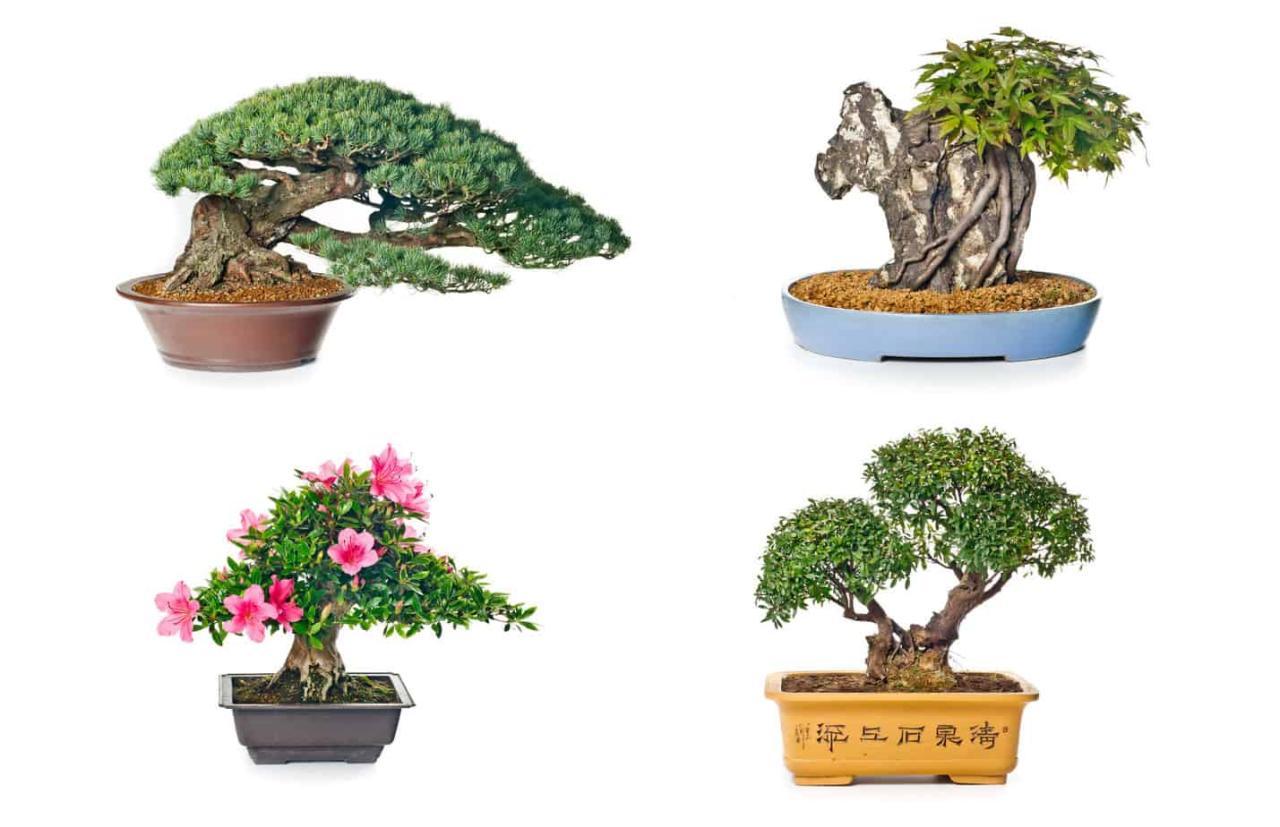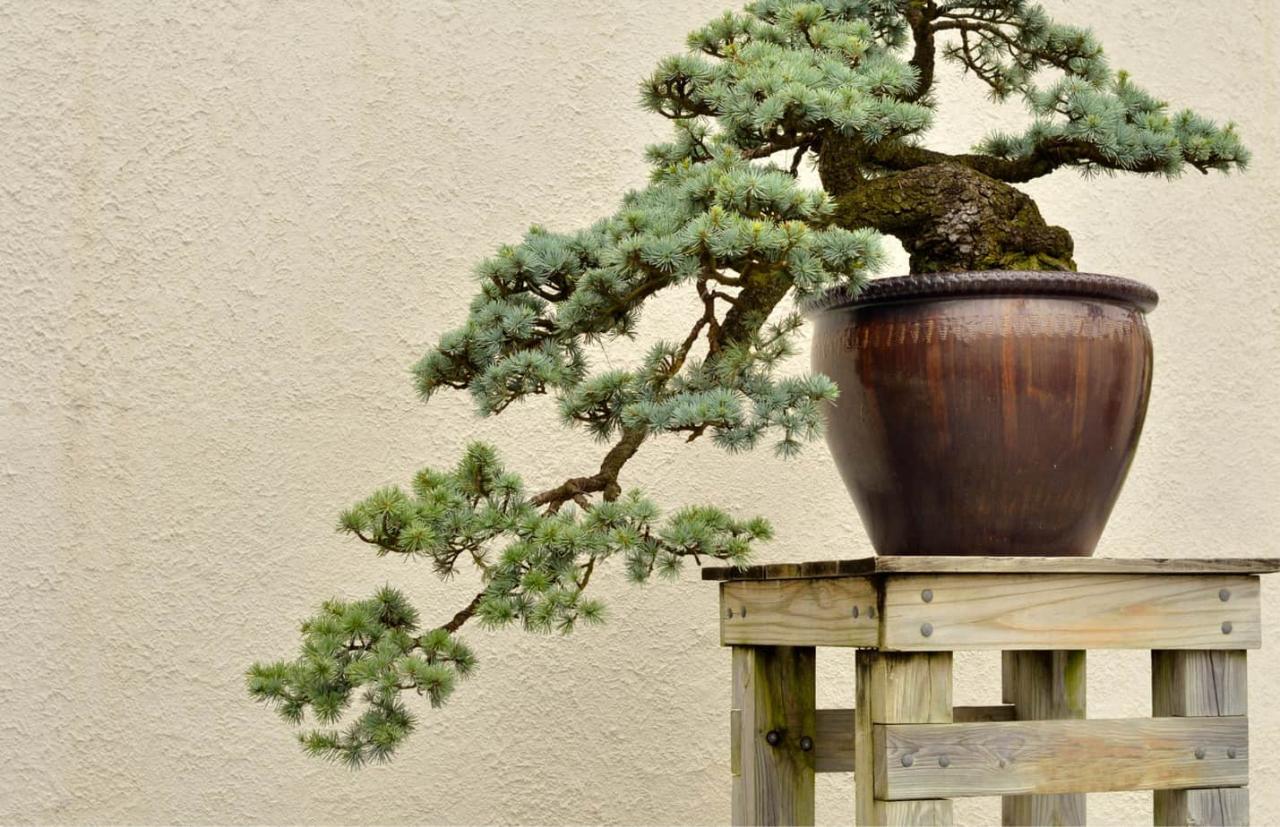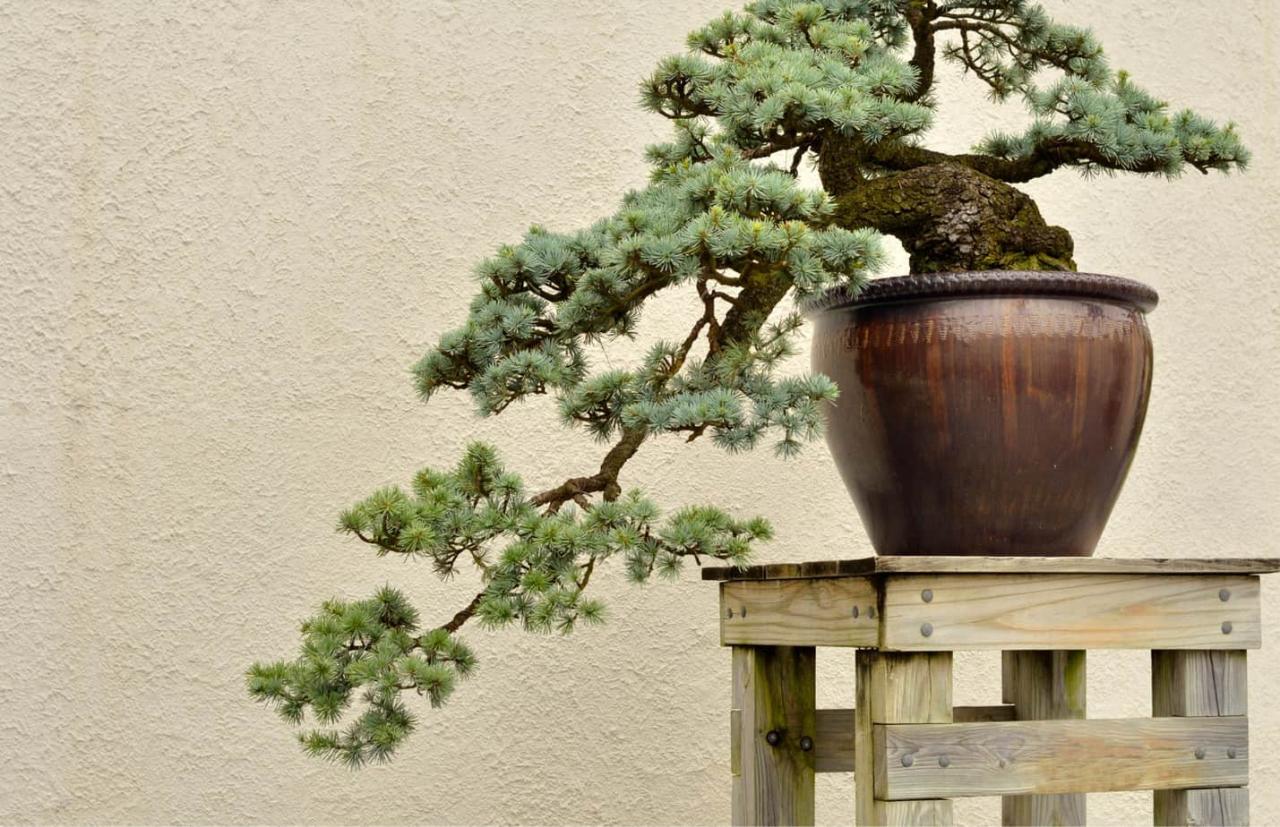How to Choose a Bonsai Pot That Suits Your Tree’s Needs is a crucial aspect of bonsai cultivation, impacting not only the tree’s aesthetics but also its health and longevity. The right pot can enhance the bonsai’s beauty, while a poorly chosen one can hinder its growth and even lead to its demise.
Understanding the nuances of pot selection is key to creating a thriving bonsai masterpiece.
The journey begins with understanding the basics of bonsai pots. We’ll delve into the significance of the pot in bonsai cultivation, exploring the diverse materials used, and examining the different pot shapes and their impact on the tree’s aesthetics.
Next, we’ll assess your bonsai tree’s needs, considering factors such as size, species, and growth habit. The importance of pot depth and width in relation to the tree’s root system will be highlighted, along with the crucial role of the pot’s drainage system in maintaining the bonsai’s health.
Understanding Bonsai Pot Basics

The pot plays a crucial role in bonsai cultivation, acting as more than just a container. It serves as a foundation for the tree’s growth, influencing its overall aesthetics, health, and even its longevity. The right pot can enhance the beauty of the bonsai, while a poorly chosen one can hinder its development and detract from its visual appeal.
Bonsai Pot Materials
The material of a bonsai pot significantly impacts its aesthetic appeal, weight, and even its ability to regulate moisture. Common materials include:
- Ceramic:This is the most popular choice due to its versatility, availability in various colors and glazes, and ability to retain moisture. Ceramic pots can be glazed or unglazed, with glazed pots being more aesthetically pleasing and offering better water retention.
However, they can be prone to cracking under extreme temperature changes.
- Stoneware:This durable material is often used for larger bonsai trees due to its weight and ability to withstand temperature fluctuations. Stoneware pots are typically unglazed, offering a rustic look and excellent drainage. However, they can be quite heavy and may require careful handling.
- Terracotta:Known for its porous nature, terracotta allows for good drainage and aeration. This material is relatively lightweight and affordable, making it ideal for beginners. However, terracotta pots are prone to cracking with temperature changes and require frequent watering due to their porous nature.
- Plastic:While not as aesthetically pleasing as other materials, plastic pots offer several advantages, including lightweight construction, affordability, and durability. They are particularly useful for beginners or for transporting bonsai trees. However, plastic pots can be less aesthetically appealing and may not provide the same level of drainage and aeration as other materials.
- Wood:Wooden bonsai pots are a beautiful and unique option, adding a natural element to the display. They can be made from various types of wood, each offering a distinctive appearance and texture. However, wooden pots are generally more expensive and require careful maintenance to prevent warping or cracking.
Bonsai Pot Shapes
The shape of a bonsai pot plays a significant role in determining the overall visual impact of the tree. Different shapes can accentuate specific features of the tree, create a sense of balance, and enhance the overall aesthetic appeal. Here are some common bonsai pot shapes:
- Rectangular:This shape is ideal for showcasing trees with a formal upright style, as it provides a stable and symmetrical base. Rectangular pots are also suitable for cascading styles, where the branches gracefully drape over the edge of the pot.
- Round:Round pots offer a sense of harmony and balance, making them suitable for a wide range of bonsai styles. They are particularly effective for trees with a natural, informal look.
- Oval:Similar to round pots, oval pots provide a sense of balance and harmony. However, their elongated shape can help to accentuate the verticality of the tree, making them suitable for upright styles.
- Square:Square pots offer a more contemporary and minimalist aesthetic. They can be effective for trees with a strong, angular structure, such as those with a literati style.
- Hexagonal:This unique shape offers a distinctive visual appeal and can be used to create a sense of movement and dynamism. Hexagonal pots are often used for trees with a more informal style.
- Triangular:Triangular pots are rarely used in bonsai, but they can add a striking and unconventional element to the display. They are best suited for trees with a strong, angular structure.
Choosing the Right Size and Shape: How To Choose A Bonsai Pot That Suits Your Tree’s Needs

Selecting the appropriate pot size and shape for your bonsai is crucial, as it directly influences the tree’s growth, health, and aesthetic appeal. The pot’s dimensions should complement the bonsai’s size and shape, while the chosen shape should enhance the tree’s visual harmony and guide its development.
Pot Size
The pot’s size should be proportionate to the bonsai’s root system. Generally, a rule of thumb is to choose a pot that is slightly larger than the spread of the tree’s roots. This allows for adequate space for root growth while maintaining a visually balanced appearance.
However, the specific pot size will vary depending on the bonsai species, its age, and the desired growth rate. For instance, young bonsai trees require smaller pots to encourage denser root growth and a more compact form. Mature bonsai, on the other hand, might need larger pots to accommodate their expanded root systems.
Pot Shape, How to Choose a Bonsai Pot That Suits Your Tree’s Needs
The pot’s shape plays a significant role in shaping the bonsai’s visual appeal and growth. Different pot shapes can create different effects, influencing the bonsai’s overall presentation. For example, a rectangular pot can create a more formal and structured look, while a round pot can offer a more natural and flowing aesthetic.
Pot Shape Effects
The following table showcases various pot shapes and their effects on the bonsai’s overall presentation:| Pot Shape | Effect ||—|—|| Rectangular | Formal, structured, emphasizes verticality || Round | Natural, flowing, emphasizes curves || Oval | Balanced, versatile, complements various styles || Square | Modern, geometric, creates strong lines || Shallow | Promotes surface root development, emphasizes horizontal growth || Deep | Encourages vertical growth, suitable for tall bonsai |
Important Note:It’s crucial to choose a pot that complements the bonsai’s style and aesthetic. A pot that clashes with the tree’s natural form can detract from its overall beauty.
Incorporating Color and Glazing
The color and glaze of a bonsai pot play a crucial role in enhancing the overall aesthetic appeal of the miniature tree. The right pot can complement the bonsai’s shape, size, and style, creating a harmonious and visually pleasing composition.
Pot Color and Glazing Techniques
Pot color and glazing techniques offer a wide range of possibilities to create unique and visually captivating bonsai displays. The color of the pot can influence the perception of the bonsai’s foliage, bark, and overall form. For example, a dark-colored pot can make the foliage appear brighter and more vibrant, while a light-colored pot can create a sense of contrast and highlight the bonsai’s delicate features.Glazing techniques involve applying a protective and decorative coating to the pot’s surface.
Glazes can be transparent, opaque, or textured, and they can be applied in various colors and patterns. The choice of glaze can significantly impact the pot’s appearance and its ability to complement the bonsai’s style.
Pot Colors and Glazes for Different Bonsai Styles
The following table illustrates how different pot colors and glazes can be used to complement various bonsai styles:| Bonsai Style | Pot Color | Glaze ||—|—|—|| Formal Upright | Dark Brown, Black | Matte, Crackled || Informal Upright | Light Brown, Gray | Semi-Gloss, Shimmering || Slanting | Red, Orange | Glossy, Smooth || Cascade | Green, Blue | Textured, Rough || Literati | White, Ivory | Matte, Rustic || Windswept | Yellow, Gold | Glossy, Metallic |For example, a formal upright bonsai style, characterized by its symmetrical and upright growth, can be complemented by a dark brown or black pot with a matte or crackled glaze.
This combination creates a sense of formality and sophistication, enhancing the bonsai’s classic elegance.In contrast, a windswept bonsai style, known for its dynamic and wind-blown appearance, can be enhanced by a yellow or gold pot with a glossy, metallic glaze.
This combination adds a sense of movement and energy, reflecting the bonsai’s dynamic form.By carefully considering the color and glazing techniques, bonsai enthusiasts can select pots that not only protect their trees but also elevate their aesthetic appeal, creating harmonious and visually captivating displays.
Practical Considerations
Choosing the right bonsai pot is not only about aesthetics; it’s about ensuring your tree’s health and longevity. Practical factors like stability, drainage, and maintenance play a crucial role in creating a thriving bonsai environment.
Pot Stability
A stable pot is essential for the well-being of your bonsai. An unstable pot can easily tip over, potentially damaging the tree’s delicate roots and branches.
- Choose a pot with a wide base:A wider base provides a larger footprint, increasing stability and reducing the risk of tipping.
- Consider the weight of the tree:Heavier trees require pots with a wider base or a heavier material to maintain balance.
- Use a heavy pot:Pots made of heavier materials like ceramic or stoneware are more stable than lighter pots made of plastic or wood.
Drainage
Proper drainage is critical for bonsai health, as it prevents root rot caused by excessive moisture.
- Look for pots with drainage holes:Drainage holes allow excess water to escape, preventing the soil from becoming waterlogged.
- Check the size and number of drainage holes:Larger and more numerous holes ensure efficient drainage.
- Use a drainage layer:A layer of gravel or pebbles at the bottom of the pot improves drainage and prevents the soil from clogging the holes.
Pot Maintenance
Maintaining the cleanliness of your bonsai pot is essential for preventing algae growth and maintaining a healthy environment for your tree.
- Clean the pot regularly:Use a mild soap solution to remove dirt and debris.
- Rinse thoroughly:Ensure all soap residue is removed to avoid harming the tree.
- Use a brush for hard-to-reach areas:A soft-bristled brush can help remove algae and debris from crevices.
Final Review
Choosing the perfect bonsai pot is an art form that requires careful consideration of both aesthetic and practical factors. By understanding the fundamentals of pot selection, you can create a harmonious balance between the tree and its container, fostering a thriving bonsai that will bring you joy for years to come.
Remember, the right pot can elevate your bonsai to new heights, enhancing its beauty and showcasing its unique character.
Detailed FAQs
What are some common materials used for bonsai pots?
Bonsai pots are typically made from materials like ceramic, clay, stone, and even wood. Each material has its own unique properties and aesthetic appeal.
How do I know if a pot has good drainage?
Look for pots with drainage holes at the bottom to ensure proper water flow and prevent root rot.
What is the best way to clean a bonsai pot?
Use a soft brush and mild soap to gently clean the pot, avoiding harsh chemicals that can damage the glaze.
Can I use a regular flower pot for my bonsai?
While you can use a regular flower pot, bonsai pots are designed specifically for bonsai trees and offer better drainage and aesthetics.
